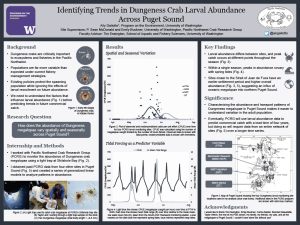Identifying Trends in Dungeness Crab Larval Abundance Across Puget Sound
Dungeness crab (Cancer magister) populations declined unexpectedly and dramatically in South Puget Sound over the last decade. While the exact cause of collapse remains unknown, larval dynamics and recruitment processes were likely involved. Assuming the population is recruitment-limited, abundance and transport patterns of Dungeness megalopae (the final larval stage) can be used to make predictions about future adult population levels. This study aimed to explore the spatial and temporal variation of Dungeness megalopae in Puget Sound, and to identify patterns in abundance that correlate with changes in tidal forcing. I worked with Pacific Northwest Crab Research Group (PCRG) to track larval abundance at a sampling site in Seattle, and I obtained past data from four other locations in Puget Sound. I then modeled catch over time to compare the sites and fit relevant predictor variables. I found that megalopae abundance is higher and the settlement period is earlier at sites near the Strait of Juan de Fuca, suggesting an influx of oceanic megalopae into northern Puget Sound. Short-term peaks in abundance appear to coincide with spring tides, confirming the role of tidal forcing in larval transport. Overall, megalopae abundance is determined by the spring-neap tidal cycle, the timing of springtime upwelling, and circulation between the Pacific Ocean and inland waters. These results provide insight into the complex processes that drive settlement and recruitment in Dungeness populations. Eventually, PCRG will use megalopae abundance data to predict commercial catch four years in advance, allowing fishery managers to create sustainable, long-term management strategies.
